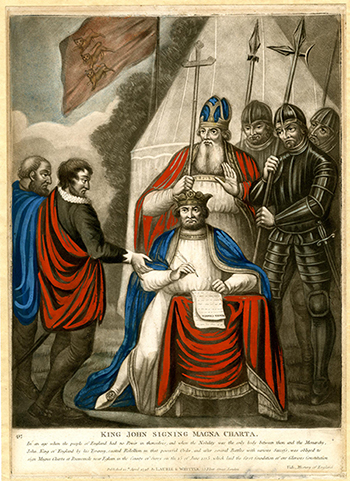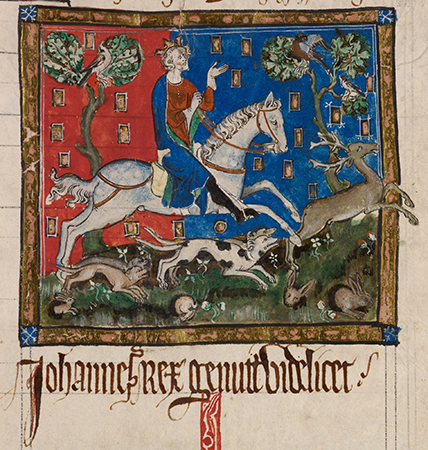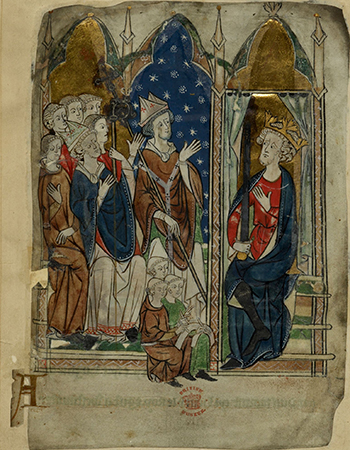The Magna Carta owned by the Australian nation
I should like to say that the statement of Magna Carta … is the whole basis of the rule of law. It is because of the development of the rule of law that we today enjoy the benefits of a free democracy. Therefore, this remains one of the great documents of our history. It will be a source of great pride to us to feel that we have in this place one of the ancient copies of this document.
– The Rt Hon. Robert Gordon Menzies, Prime Minister of Australia, House of Representatives, 19 August 1952.
Magna Carta (Latin for ‘Great Charter’) is celebrated as a founding document in the development of constitutional and parliamentary government. The Magna Carta is a charter of liberties first granted in June 1215 by King John of England as a treaty of rights and concessions to end a baron-led revolt.
From its articles emerged the concept that nobody, not even the king, is above the rule of law. Its principles have been incorporated into the common law of many nations and embodied in such documents as the United States Declaration of Independence and Constitution and the Universal Declaration of Human Rights and in the development of responsible government.
While the Magna Carta was annulled soon after being granted, it would be revised and reissued throughout the 13th century, as King John’s successors each faced their own political crises, including by King Edward I in 1297. However, very few 13th century copies of the Magna Carta are known to survive.
In 1952 Prime Minister Robert Menzies announced that the Australian Government had purchased a 1297 Inspeximus issue the Magna Carta for the nation. It had been discovered at King’s School, Bruton, in Somerset, England in the 1930s. The document was first placed on public display in Australia in 1961. It is one of only four known surviving copies of the 1297 charter, and until recently one of only two copies of the Magna Carta known to be held outside of the UK, the other at the US National Archives. However, in 2025 another Magna Carta, a 1300 certified issue, was discovered in the US at Harvard University Law School.
The document is a single sheet of sheepskin parchment inscribed with iron-gall ink. King Edward I’s royal seal is attached by red and green braided silk cords.
Between 2016 and 2024 a major conservation project has not only enhanced understanding of the Magna Carta’s history but also contributed to its preservation for future generations.

National and Parliamentary Librarian Harold White (left), Director of the British Museum, Sir Frank Francis (centre) and Sir Grenfell Price, Chairman of the Council of the National Library, inspect the Magna Carta in King’s Hall, Parliament House, Canberra, 1963 Courtesy of the National Archives of Australia, A1200, L43177.
What is the Magna Carta?

Laurie & Whittle 1798 King John signing Magna ‘Charta’ Reproduction © The Trustees of the British Museum.
The Magna Carta is one of the world’s most famous documents, celebrated as a cornerstone of constitutional government. Such is its totemic status; it is more frequently referenced than read. From its articles emerged the concept that nobody, not even the king, is above the rule of law.
Legal principles such as due process under the law and trial by jury have also been traced to provisions in the Magna Carta, as has the gradual and contested emergence of parliamentary democracy. Over the centuries, its principles have been incorporated into legal codes and embodied in such foundational documents as the 1789 Declaration of the Rights of Man and the 1948 United Nations Universal Declaration of Human Rights.
The Magna Carta, or ‘Great Charter’, was first granted in June 1215 by King John of England as a treaty of rights and concessions to end a baron-led revolt. A charter was any proclamation or letter granting property or rights. Henry I, King Stephen, and Henry II had previously issued ‘coronation charters’ establishing ‘traditions’ that the kings swore to reinstate and uphold. Indeed, Henry I’s coronation charter was cited as a precedent by the rebel barons.

King John, hunting on horseback reproduction from 14th-century manuscript, courtesy of the British Library.
In the Magna Carta, King John undertook to restore and uphold ‘traditional’ customs and liberties granted to the Church, nobles and ‘free men’. In a subsequent writ John stated that ‘a firm peace’ had been resolved ‘between us and the barons and free men of our kingdom as they can hear and see by our charter’. However, less than two months later John’s ‘great charter’ was annulled, leading to civil war and the invasion of England by France.
The story of the Magna Carta did not end there. Throughout the 13th century, it was revised and reissued by John’s successors as each faced their own political crises. Only a month after John’s death in 1216, proxies for his young son Henry III issued a revised and shortened Magna Carta as a promise of good government. It was further amended and reissued in 1217 and 1225. In 1297 and 1300 Henry’s son and successor, Edward I, confirmed the 1225 version with minor amendments and issued the Inspeximus Magna Carta. The 1297 issue was entered on the Statute Roll of the Chancery.
Clerks in the Royal Chancery produced these manuscripts. Their role was to draft, copy, and certify documents, with the King’s Seal affixed as a sign of official authentication. In the 1200s, the Chancery began recording all issued charters and letters on a series of rolls.6 For each reissue of the Magna Carta, the King’s official Chancery Scribes produced and certified copies which were then proclaimed – read aloud in a public place – in all English counties and major towns. Notably, the frequency of which the Magna Carta and other charters were issued – almost a dozen occasions in Henry’s reign alone – testifies to the early monarchs’ reluctance to have their authority constrained.
The 1297 Inspeximus issue of the Magna Carta
The 1297 Inspeximus issue of the Magna Carta owned by the Australian nation is an official charter sent in Edward I’s name for public proclamation. The term inspeximus means that the King had inspected and confirmed the great charter of his father Henry III. It closes with an admonition that the charter be observed in perpetuity. It was witnessed by Edward’s son (later Edward II) at Westminster during the King’s absence campaigning in Flanders. It was originally accompanied by the reissued ‘Charter of the Forest’, now held by the British Library, which established access to the royal forests for ‘free men’.
The hand-written document or ‘manuscript’ is written in iron-gall ink on a single sheet of sheepskin parchment. Chancery Clerk Hugh of Yarmouth signed (‘warranted’) the manuscript. The various inscriptions on the back of the document include confirmation that the text was reviewed and declared by Edward I in 1297.

Edward I and his court, Miscellaneous chronicles, c. 1280-1300, courtesy of the British Library.
The text is written in Latin, the language of the Church and government, even though French was used at the Royal Court at the time. Its ‘standard chancery hand’ which incorporated an established and comprehensive abbreviating system designed to save time and parchment. Edward I’s Royal Seal is attached to the folded lower edge by red and green silk cords. On close inspection, the scribe’s pale grey horizontal guiding lines can be identified. Much more apparent are the vertical and horizontal creases, revealing that the manuscript has been previously folded into as many as 16 sections.